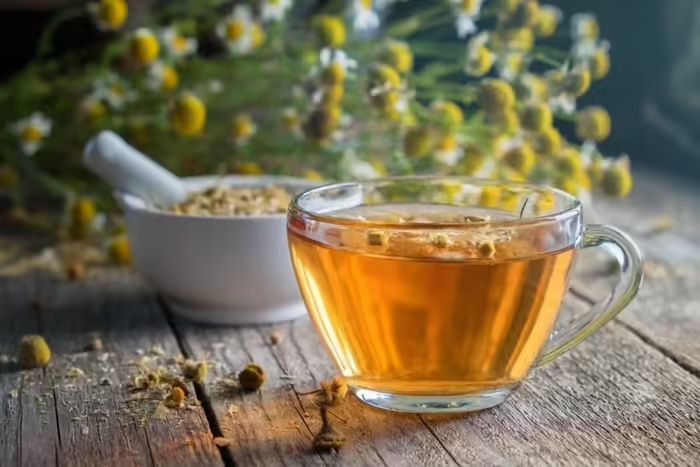By Amy Denney
When herbalist Rosalee de la Forêt says chamomile doesn’t get the respect it deserves, she’s speaking from firsthand experience.
She once accidentally let chamomile flowers steep too long in water and discovered an exceptionally potent drink for digestive issues. Suddenly, de la Forêt understood she’d been discounting chamomile.
“I always thought it was a cute little herb that’s sold in every coffee shop, but it wasn’t like real herbal medicine,” she told The Epoch Times. “I really got schooled on it. I made a very strong batch of it and felt how dramatic it was and its effects on digestive health. I fell in love with chamomile and cannot live without it.”
Calling herself a skeptic-turned-die-hard lover of chamomile, she now recommends the herb to nearly everyone.
A flower that grows just about anywhere and is found abundantly in most parts of the world, chamomile is regarded for its gastrointestinal applications. It has a rich history of medicinal uses in many cultures and is also used in cosmetic products and food because of its aromatic properties.
Chamomile extract for gastrointestinal (GI) health can be used for its carminative effect, meaning to help in expelling gas. This makes chamomile useful for colic, indigestion, bloating, and abdominal pain. The popular herb is also considered a mucilage—used in medicine for creating a soothing, protective coating. The herb can be used for irritated intestinal mucosa, as well as for diarrhea and vomiting.
Mechanism of Action
A review in the International Journal of Food Properties details the various biochemical plant compounds found in chamomile that give it anti-inflammatory effects. These are what make it a potential alternative therapy or adjuvant to other treatments for chronic inflammatory diseases.
Chamomile contains bisabolol, an oil with anti-inflammatory, analgesic, antibacterial, anticancer, antibacterial, and antiseptic properties. Bisabolol is capable of reducing pepsin, the digestive enzyme that can cause digestive issues. This could make chamomile an alternative treatment for stomach and upper intestinal symptoms, according to the review.
Chamomile’s chemical makeup contains many terpenoids, plant compounds that act as antioxidants—meaning they reduces reactive oxygen species that are linked to disease. Terpenoids are “anticancer, antimicrobial, anti-inflammatory, antioxidant, and antiallergic,” according to the review.
Further, the review noted the herb’s ability to inhibit the body’s pro-inflammatory pathways by downregulating cytokines, signaling proteins that direct the immune system’s responses.
These compounds explain how chamomile would be useful for various human diseases, such as cancer, microbial infections, and ulcers like those common in inflammatory bowel diseases (IBD), which includes Crohn’s disease and ulcerative colitis. IBD also causes inflammatory ulcers along the GI tract with symptoms like diarrhea, blood in the stool, reduced appetite and weight loss, abdominal pain and cramping, and fatigue.
Chamomile and IBS
Those with irritable bowel syndrome (IBS) may also benefit from chamomile. People who took a combination of chamomile, licorice root, and yarrow had statistically significant improvements in IBS symptoms compared to a control group in a double-blinded clinical trial.
Published in Chronic Disease Journal in 2023, the study of 102 participants found the group taking the chamomile mixture had significant improvements in constipation, diarrhea, and mucus excretion after two weeks, and in abdominal pain, bloating, constipation, and diarrhea after four weeks.
Besides helping with digestive symptoms, chamomile can be an effective tool for anxiety. Anxiety can contribute to IBS and worsen digestive symptoms. Chamomile is also known for its calming effects—often used in bedtime tea blends or as a mild sedative.
“If somebody wasn’t digesting food well because they were stressed or overwhelmed, chamomile is a very relaxing nervine,” de la Forêt said, explaining the herbal terminology for a tonic that calms the nervous system.
“It helps relax the nervous system so it can help promote healthy digestion while also calming the nervous system, which of course also helps digestion,” she added.
Useful for Cancer Patients
Chamomile’s ability to improve both mood and gut symptoms might also make it a handy adjunctive treatment for cancer patients. This is the question explored in a review published in 2023 in Integrative Cancer Therapies. Adjunctive treatments are treatments used in addition to the primary treatment of cancer.
The review included 15 randomized controlled trials examining a range of applications—mouthwash, topical, capsule, and tincture. Researchers noted the overall benefit on quality of life, as well as gut-brain benefits of reducing depression, vomiting, and mouth ulcers.
The effects are due to the anticancer, chemopreventive, and antioxidant properties of chamomile, according to the review.
“Chamomile as an herbal medicine has increasingly gained the attention of healthcare providers over the past decade,” the review stated. “The use of chamomile as a non-pharmacologic and safe method can be helpful for mitigating cancer complications in cancer patients.”
Starting Slow
Anyone wanting to try chamomile may want to start with low dosing and mild variations, according to de la Forêt.
Chamomile could change the way anticoagulant (anticlotting) medications work, increase the sedative effect of alcohol and other drugs, and interfere with hormones found in birth control and hormone therapies, according to the consumer edition of Merck Manual, a medical reference. Anyone using these medications should talk to their doctor about chamomile.
While it’s generally considered a safe herb, chamomile can also cause allergic reactions—particularly for those who are allergic to ragweed or sunflowers. All three flowers are in the same family, Asteraceae.
Reactions to look for include itchy eyes, sneezing, runny nose, and skin irritation. Severe and life-threatening reactions such as anaphylaxis are rare.
Be on the lookout for an itchy throat, too, said de la Forêt. Because allergic reactions tend to be mild, she said trying it a few times and gradually increasing the dosage is a reasonable approach to gauge tolerance of the plant.
Another reason to start slow is because of the effect—and taste—of stronger doses, she said.
“I do love chamomile because it’s so easy for people to get their hands on,” she said. “One trick with chamomile that would help it get it from the underrated realm and more in the wow-isn’t-this-an-amazing herb realm is that the dosage can make a big difference, as well as how we prepare it.”
How to Take Chamomile
There are a number of ways to take chamomile. The most common ones are tea, tincture, and supplements.
It’s an accessible herb found in a number of products and stores, de la Forêt said. You can also use dried flowers to make your own tea, tincture, or even topical ointment.
If you want a relaxing, enjoyable drink with minimal effects, she said steep a teaspoon to tablespoon of chamomile in a cup of hot water for an after-dinner tea.
However, as de la Forêt put it: She wouldn’t bet on chamomile that’s only steeped for three minutes—especially for chronic GI issues. Chamomile’s power is often in longer steeping.
To make it more potent, steep a half-cup of dried flowers in a pint of hot water for 10 to 15 minutes. You may also consider a gradual increase in the time of steeping to transition your taste buds from the more pleasant aromatic to the bitterness of its stronger variation.
“This brew is going to be much stronger and much more bitter, but it’s really, really potent medicine. That really strong brew makes a difference,” de la Forêt said.






